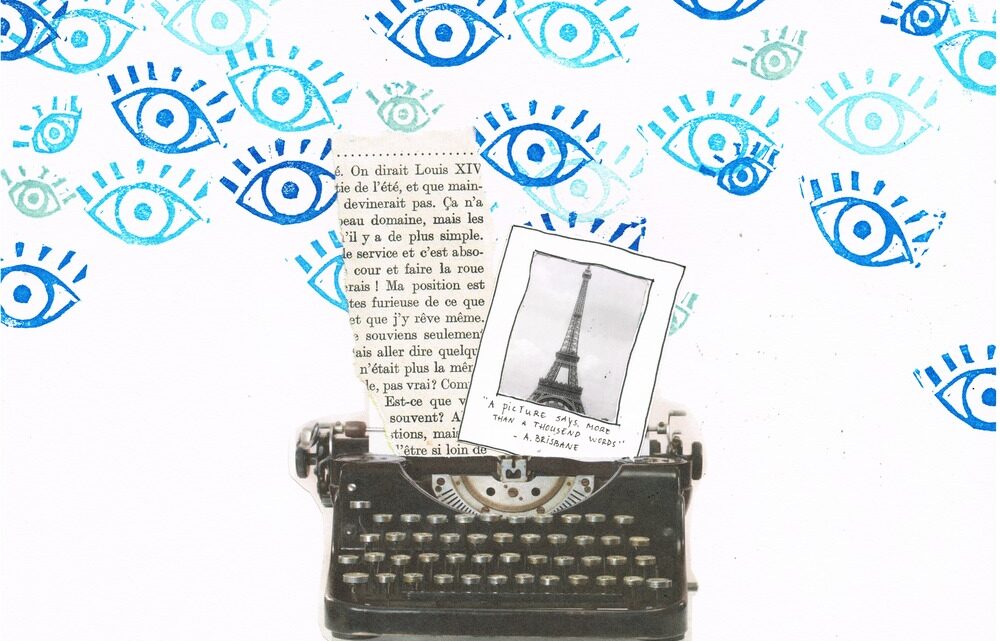The ‘Photographic Memory’ of the Newsreader
When the French Republic, in June 1848, decided to suspend their plans to provide the workless with a minimum wage, it led to unrest among the French population. A crowd of disgruntled citizens came to their feet, in a riot which was known as les journées de Juin, the days of June.1
During those days, a journalist from the French newspaper L’Illustration must have been present. In all probability carrying one of the first commercial cameras, as they first appeared on the French market in 1839.2 That journalist must then have taken a picture of the barricades that the French National Guard had set up to intercept the rebellion.
This famous photograph appeared a week later in L’Illustration, being the first ever printed photograph in a newspaper.3 Ever since photography has been an integral part of the news.

The first ever printed photograph in a newspaper.
Hence, it was an editor, Arthur Brisbane, a renowned one of many major American newspapers at the time, who in March 1911 during a banquet on journalism and publicity, made the now well-known statement: “A picture says more than a thousand words”.4
The impact of the photo on the news should not be underestimated. From choosing which article we read, to how we will remember it, the photo plays a crucial part in every step. This becomes clear in the very first step: when we open up the news. Immediately we start staring at the visual stimuli that the site has to offer: the logo, the flashy buttons, and thus also the imagery.5, 6 It is therefore not surprising that people are more inclined to read an article if the text is accompanied by a photo.7, 8

Results from an eye-tracking study, the spots highlight where people tend to gaze.6
Our brain is simply calibrated to visual information. Namely, the human brain processes visual information 60,000 times faster than text.9 We, people, are naturally born with the ability to recognize images quickly. We are so good at recognizing images that the brain only needs 13 milliseconds to recognize unfamiliar photos.10 For comparison: blinking takes us 100 to 400 milliseconds.11 So in one blink of an eye you could have processed 10 to 30 images.
Text, funnily enough, is also processed as an image. Only our brain sees each word as a separate image, which makes that every word needs to be processed separately as well.12 In addition, our brain must take into account the order of these images, given that the sequence of words can vastly change the message of a phrase. In short, it is just more efficient to rely on images for the brain. This applies to booking holidays, shopping online, swiping on Tinder, and thus also to which news to consume.
So, after a brief moment of gazing at the website, the visual stimuli have brought us to an article. Although the photo is no longer actively thought about, now that we are actually reading the text, it remains lurking in our heads. The photo is namely the first thing we saw, therefore providing us with the first context of the story. Often that photo is not a direct reflection of reality, but a selective simplification of it. This already pushes the reader’s mind in a certain direction.13
To exemplify, two images are provided below that attempt to portray the European refugee crisis. The photo on the left is shot from a distance, individual faces are barely recognisable. The photo mainly shows a crowd of people. The photo on the right is a close-up, making it possible to see the tiredness on the father’s face. The photo shows a family instead of a crowd. Even a neutral story on migration, providing realistic numbers and telling truthful experiences, can be remembered differently by the reader, simply depending on which photo accompanied the story. Visually highlighting the anonymity and massiveness of the crowd will have a negative impact on reader support for the reception of migrants, whereas the humane exposure, on the right, can actually increase support.14 In that sense, a picture indeed says more than a thousand words.

Images of the 2015 European refugee crisis.
How can it be that just a subtle change in imagery can leave the reader with such different thoughts? The neurological explanation is that just as our brain processes visual information more easily than text, it also stores that information more easily.15 This is the reason why we are better at recognizing people’s faces, instead of their names. Whereas text is only stored once in our memory, simply as text, imagery is stored twice: as the image itself, as well as a text. Furthermore, images have more unique visual characteristics than text, making them more recognizable: where images can vary endlessly, our language consists of a limited set of words.16 A picture thus sticks to our mind more than a piece of text.
The psychological explanation for our obsession with pictures is that people place more trust in visual information.17 A photo in the news serves as a cue to demonstrate that an event actually took place. The creed seeing is believing applies. However, people tend to rely so strongly on visual information that it can trigger false memories.18 If in an experiment, people are confronted with false headlines, so headlines of events that never even occurred, people are more likely to remember the made-up event anyway, when a photo is put next to it, compared to when there is none.
The same cognitive link, that an image inherently contains truth, also leads people to approach images in the media less critically. To illustrate, in the US, African Americans are more often stereotyped in the media than Caucasian Americans.19 For example, when discussing the burdens of the welfare state, it often includes pictures of African Americans, implying that they are the people ‘who need care’. There is rarely a fuss over the choice of these racially charged images. However, if an article were to use language to explicitly and emphatically mention race in a story on welfare, it would result in moral outrage. But images seem to be rather immune to moral judgment. The reader sees the text as interpretation and the imagery as reality. But just as a journalist chooses his or her words, which photo to include is also a choice and, as we have seen with the images on migration, determines how the reader will remember the story.
The choice of whether and which photo to put with an article can thus determine if and how people will experience a news story. That choice often does not even lie with the journalists themselves but is normally taken by an editorial board. Arthur Brisbane, as stated before an editor himself, probably understood that this was a decisive choice, why else would he have said that a picture says more than a thousand words?
Endnotes
- Peacock, H. L. (1982). A History of Modern Europe, 1789-1981. Heinemann Educational Publishers.
- Gustavson, T., & House, G. E. (2009). Camera: A History of Photography from Daguerreotype to Digital. Sterling Publishing Co.
- Anido, J., & Anido, J. (2020, May 24). The first photo of a barricade. Un Jour De Plus À Paris. https://www.unjourdeplusaparis.com/en/paris-reportage/premiere-photo-barricade-histoire
- Syracuse Post Standard (1911, March 28). Speakers Give Sound Advice.
- Buscher, G., Cutrell, E., & Morris, M. R. (2009, April). What do you see when you’re surfing? Using eye tracking to predict salient regions of web pages. In Proceedings of the SIGCHI conference on human factors in computing systems (pp. 21-30). https://doi.org/10.1145/1518701.1518705
- Djamasbi, S. (2014). Eye Tracking and Web Experience. AIS Transactions on Human-Computer Interaction, 6(2), 37–54. https://doi.org/10.17705/1thci.00060
- Zillmann, D., Knobloch, S., & Yu, H. (2001). Effects of Photographs on the Selective Reading of News Reports. Media Psychology, 3(4), 301–324. https://doi.org/10.1207/s1532785xmep0304_01
- Jiang, T., Guo, Q., Chen, S., & Yang, J. (2019). What prompts users to click on news headlines? Evidence from unobtrusive data analysis. Aslib Journal of Information Management, 72(1), 49–66. https://doi.org/10.1108/ajim-04-2019-0097
- Tarkhova, L. G., Tarkhov, S. A., Nafikov, M., Akhmetyanov, I., Gusev, D. G., & Akhmarov, R. (2020). Infographics and Their Application in the Educational Process. International Journal of Emerging Technologies in Learning (Ijet), 15(13), 63. https://doi.org/10.3991/ijet.v15i13.14647
- In the blink of an eye. (2014, January 16). MIT News | Massachusetts Institute of Technology. https://news.mit.edu/2014/in-the-blink-of-an-eye-0116
- Average duration of a single eye blink (n.d.). https://bionumbers.hms.harvard.edu/bionumber.aspx?id=100706
- Sutherland, S. (2015). What Happens in the Brain When We Read?. Scientific American Mind, 26(4), 14-14.
- Zhang, X., & Hellmueller, L. (2017). Visual framing of the European refugee crisis in Der Spiegel and CNN International: Global journalism in news photographs. International Communication Gazette, 79(5), 483–510. https://doi.org/10.1177/1748048516688134.
- Powell, T. D., Boomgaarden, H. G., De Swert, K., & De Vreese, C. H. (2019). Framing fast and slow: a dual processing account of multimodal framing effects. Media Psychology, 22(4), 572–600. https://doi.org/10.1080/15213269.2018.147689
- Grady, C. A., McIntosh, A. M., Rajah, M. N., & Craik, F. I. M. (1998). Neural correlates of the episodic encoding of pictures and words. Proceedings of the National Academy of Sciences of the United States of America, 95(5), 2703–2708. https://doi.org/10.1073/pnas.95.5.2703
- Hockley W. E. (2008). The picture superiority effect in associative recognition. Memory & cognition, 36(7), 1351–1359. https://doi.org/10.3758/MC.36.7.1351
- Newman, E., & Feigenson, N. (2013). The truthiness of visual evidence. Jury Expert, 25, 9.
- Strange, D., Garry, M., Bernstein, D., & Lindsay, D. S. (2011). Photographs cause false memories for the news. Acta Psychologica, 136(1), 90–94. https://doi.org/10.1016/j.actpsy.2010.10.006
- Messaris, P., & Abraham, L. (2001). The role of images in framing news stories. In Framing public life (pp. 231-242). Routledge.

Roeland Dubèl (1999) is a second-year Research Master’s student in Communication Science. His interests within the science of communication are in how the digitalisation of our media environment has affected our news consumption patterns, as well as how mediated political content can affect us emotionally. In his eyes, the goal of any science should be to answer as many questions as broadly and profoundly as possible. It is the ground for his passion for interdisciplinary science. Within his study, he loves to apply digital methods from the computational sciences, but he also has an interest in using physiological measurements from psychology and the neurosciences (to measure emotional reactions in specific). It reflects his key idea that one is better able to answer questions when one looks at it interdisciplinary.

